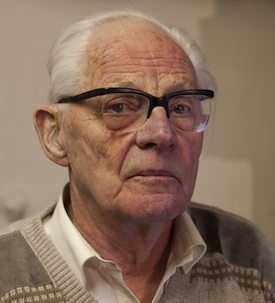Alan Lindsay Mackay facts for kids
Quick facts for kids
Alan Lindsay Mackay
|
|
|---|---|
 |
|
| Born | 6 September 1926 Wolverhampton, England
|
| Alma mater | Oundle School University of Cambridge Birkbeck College, University of London |
| Known for | Quasicrystals, Mackay icosahedra, periodic minimal surfaces, generalised crystallography |
| Awards | Buckley Prize |
| Scientific career | |
| Fields | Crystallography |
| Institutions | Birkbeck College |
| Doctoral advisor | John Desmond Bernal |
Alan Lindsay Mackay (born 6 September 1926) is a British scientist. He is known for his important work in crystallography, which is the study of how atoms are arranged in solid materials.
Alan Mackay was born in Wolverhampton, England. He went to schools like Oundle School and studied at the University of Cambridge and the University of London. He earned his doctorate degree from the University of London. Most of his scientific career was spent at Birkbeck College, which is part of the University of London. There, he worked in a very open and scientific environment led by John Desmond Bernal.
Contents
Discovering New Material Structures
Alan Mackay made big discoveries about how materials are built. He helped us understand new ways atoms can arrange themselves.
Mackay Icosahedra
In 1962, he wrote about how atoms could be packed together in a shape called an icosahedron. An icosahedron is a shape with 20 flat faces. These special arrangements of atoms are now called Mackay icosahedra. This was an early step towards understanding materials with a unique kind of symmetry.
Predicting Quasicrystals
Mackay was a leader in introducing the idea of "five-fold symmetry" in materials. This means a shape looks the same if you turn it by one-fifth of a full circle. Regular crystals don't usually have this kind of symmetry.
In 1981, he predicted a new type of ordered structure called quasicrystals. He used a special pattern called a Penrose tiling to show how these structures could exist. A Penrose tiling is a pattern that never repeats itself exactly, but still has a clear order.
In 1982, he showed how to identify these quasicrystals using light. He found that if you shone light through a Penrose tiling, it would create a pattern with sharp spots and five-fold symmetry. This meant scientists could find quasicrystals in real materials using a method called diffraction.
Just a few years later, in 1984, another scientist named Dan Shechtman and his team actually found quasicrystals with icosahedral symmetry. This proved Mackay's predictions were correct.
Beyond Regular Crystals
Mackay has also been interested in a broader way to study materials, called "generalised crystallography." This field can describe not only simple crystals but also more complex structures, like tiny nanomaterials.
He applied his ideas of minimal surfaces to materials made of carbon, like graphite. Minimal surfaces are like soap films that naturally form the smallest possible surface area. With Humberto Terrones, he suggested new arrangements of carbon atoms. These are called Schwarzites, and they are related to Buckminsterfullerenes (often called "buckyballs").
Awards and Other Works
For his important work on quasicrystals, Alan Mackay received the Buckley Prize in 2010. He shared this award with Dov Levine and Paul Steinhardt. The Nobel Prize in Chemistry was later given to Dan Shechtman in 2011 for discovering quasicrystals.
Alan Mackay is also a Fellow of the Royal Society (FRS), which is a very respected group of scientists in the UK. He became a Fellow in 1988. He is also a Fellow of the Mexican Academy of Sciences.
Besides his scientific research, Mackay has written several books. He put together a book of scientific quotes and co-wrote a book about geometry. He has also written poetry and translated a book by Ernst Haeckel. He even creates scientific art under the name Sho Takahashi.

